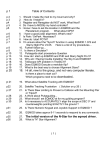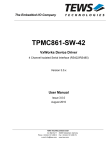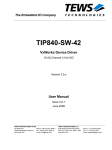Download User Manual
Transcript
The Embedded I/O Company TIP867-SW-42 VxWorks Device Driver 8 Channel Serial RS485 IP Version 3.0.x User Manual Issue 3.0.0 January 2011 TEWS TECHNOLOGIES GmbH Am Bahnhof 7 25469 Halstenbek, Germany Phone: +49 (0) 4101 4058 0 Fax: +49 (0) 4101 4058 19 e-mail: [email protected] www.tews.com TIP867-SW-42 This document contains information, which is proprietary to TEWS TECHNOLOGIES GmbH. Any reproduction without written permission is forbidden. VxWorks Device Driver 8 Channel Serial RS485 IP TEWS TECHNOLOGIES GmbH has made any effort to ensure that this manual is accurate and complete. However TEWS TECHNOLOGIES GmbH reserves the right to change the product described in this document at any time without notice. Supported Modules: TIP867 TEWS TECHNOLOGIES GmbH is not liable for any damage arising out of the application or use of the device described herein. 1998-2011 by TEWS TECHNOLOGIES GmbH Issue Description Date 1.0 First Issue May 1998 1.1 General Revision November 2003 2.0.0 IPAC CARRIER driver support and new user interface October 19, 2006 2.0.1 Carrier Driver description added June 24, 2008 3.0.0 Function of tip867Drv() and tip867DevCreate() modified, SMP-Support added , Address TEWS LLC removed January 21, 2011 TIP867-SW-42 – VxWorks Device Driver Page 2 of 33 Table of Contents 1 INTRODUCTION......................................................................................................... 4 1.1 Device Driver ...................................................................................................................................4 1.2 IPAC Carrier Driver .........................................................................................................................5 2 INSTALLATION.......................................................................................................... 6 2.1 Include Device Driver in VxWorks Projects .................................................................................6 2.2 System Resource Requirement.....................................................................................................6 2.3 Driver Configuration .......................................................................................................................7 3 I/O SYSTEM FUNCTIONS.......................................................................................... 8 3.1 tip867Drv() .......................................................................................................................................8 3.2 tip867DevCreate()..........................................................................................................................10 4 I/O FUNCTIONS ....................................................................................................... 13 4.1 4.2 4.3 4.4 4.5 open() .............................................................................................................................................13 close().............................................................................................................................................15 read() ..............................................................................................................................................17 write() .............................................................................................................................................19 ioctl() ..............................................................................................................................................21 4.5.1 FIO_TIP867_BAUDRATE ..................................................................................................23 4.5.2 FIO_TIP867_DATABITS ....................................................................................................25 4.5.3 FIO_TIP867_STOPBITS....................................................................................................26 4.5.4 FIO_TIP867_PARITY.........................................................................................................27 4.5.5 FIO_TIP867_CHECKBREAK.............................................................................................28 4.5.6 FIO_TIP867_SETBREAK ..................................................................................................29 4.5.7 FIO_TIP867_CLEARBREAK .............................................................................................30 4.5.8 FIO_TIP867_RECONFIGURE ...........................................................................................31 4.5.9 FIO_TIP867_CHECKERRORS .........................................................................................32 TIP867-SW-42 – VxWorks Device Driver Page 3 of 33 1 Introduction 1.1 Device Driver The TIP867-SW-42 VxWorks device driver software allows the operation of the TIP867 IP conforming to the VxWorks I/O system specification. This includes a device-independent basic I/O interface with open(), close(), read(), write(), and ioctl() functions and a buffered I/O interface (fopen(), fprintf(), fscanf(),…).. Special I/O operation that do not fit to the standard I/O calls will be performed by calling the ioctl() function with a specific function code and an optional function dependent argument. The TIP867-SW-42 driver includes the following functions supported by the VxWorks tty driver support library: ring buffering of input and output raw mode optional line mode with backspace and line-delete functions optional processing of X-on/X-off optional RETURN/LINEFEED conversion optional stripping of the parity bit from 8 bit input optional special characters for shell abort and system restart Additional the following functions are supported: baud rates from 2 up to 460800 BAUD use 5..8 bit data words use 1, 1.5 or 2 stop bits optional even or odd parity The TIP867-SW-42 supports the modules listed below: TIP867-10 8 channel RS485 Interface IndustryPack TIP867-20 8 channel RS485 Interface plus 8 serial RS485 clock I/O lines IndustryPack To get more information about the features and use of supported devices it is recommended to read the manuals listed below. TIP867 User manual TIP867 Engineering Manual and Z85230 SCC (Serial Controller) Manual CARRIER-SW-42 IPAC Carrier User Manual TIP867-SW-42 – VxWorks Device Driver Page 4 of 33 1.2 IPAC Carrier Driver IndustryPack (IPAC) carrier boards have different implementations of the system to IndustryPack bus bridge logic, different implementations of interrupt and error handling and so on. Also the different byte ordering (big-endian versus little-endian) of CPU boards will cause problems on accessing the IndustryPack I/O and memory spaces. To simplify the implementation of IPAC device drivers which work with any supported carrier board, TEWS TECHNOLOGIES has designed a so called Carrier Driver that hides all differences of different carrier boards under a well defined interface. The TEWS TECHNOLOGIES IPAC Carrier Driver CARRIER-SW-42 is part of this TIP867-SW-42 distribution. It is located in directory CARRIER-SW-42 on the corresponding distribution media. This IPAC Device Driver requires a properly installed IPAC Carrier Driver. Due to the design of the Carrier Driver, it is sufficient to install the IPAC Carrier Driver once, even if multiple IPAC Device Drivers are used. Please refer to the CARRIER-SW-65 User Manual for a detailed description how to install and setup the CARRIER-SW-42 device driver, and for a description of the TEWS TECHNOLOGIES IPAC Carrier Driver concept. TIP867-SW-42 – VxWorks Device Driver Page 5 of 33 2 Installation Following files are located on the distribution media: Directory path ‘TIP867-SW-42’: tip867drv.c tip867def.h tip867.h tip867exa.c include/ipac_carrier.h TIP867-SW-42-3.0.0.pdf ChangeLog.txt Release.txt TIP867 device driver source TIP867 driver include file TIP867 include file for driver and application Example application Carrier driver interface definitions PDF copy of this manual Release history Release information 2.1 Include Device Driver in VxWorks Projects For including the TIP867-SW-42 device driver into a VxWorks project (e.g. Tornado IDE or Workbench) follow the steps below: (1) Copy the files from the distribution media into a subdirectory in your project path. (For example: ./TIP867) (2) Add the device drivers C-files to your project. (3) Now the driver is included in the project and will be built with the project. For a more detailed description of the project facility please refer to your VxWorks User’s Guide (e.g. Tornado, Workbench, etc.) 2.2 System Resource Requirement The table gives an overview over the system resources that will be needed by the driver. Resource Driver requirement Devices requirement Memory < 1 KB < 1 KB Stack < 1 KB --- Memory and Stack usage may differ from system to system, depending on the used compiler and its setup. The following formula shows the way to calculate the common requirements of the driver and devices. <total requirement> = <driver requirement> + (<number of devices> * <device requirement>) The maximum usage of some resources is limited by adjustable parameters. If the application and driver exceed these limits, increase the according values in your project. TIP867-SW-42 – VxWorks Device Driver Page 6 of 33 2.3 Driver Configuration To adjust the default behavior of the TIP867 device driver, refer to file tip867conf.h and look for the following symbols. TIP867_MAX_MODULES This symbol defines the maximum count of supported TIP867 modules. You can increase it to match your system requirements. The default value is 10. TIP867_DEFAULT_BAUDRATE This symbol defines the start up speed for all found channels. To modify input and output speed at runtime use the FIO_TIP867_BAUDRATE ioctl function. The total default configuration of each channel consists of TIP867_DEFAULT_BAUDRATE, 8 data bits, no parity and one stop bit. TIP867_DEFAULT_OPTIONS This symbol defines the default VxWorks terminal settings for each serial channel. For more details see also ioLib.h and tyLib.h and look for “OPT_..:” flags. TIP867-SW-42 – VxWorks Device Driver Page 7 of 33 3 I/O System Functions This chapter describes the driver-level interface to the I/O system. The purpose of these functions is to install the driver in the I/O system, add and initialize devices. 3.1 tip867Drv() NAME tip867Drv() - installs the TIP867 driver in the I/O system SYNOPSIS #include “tip867.h” STATUS tip867Drv ( void ) DESCRIPTION This function initializes the TIP867 driver and installs it in the I/O system. The driver searches for TIP867 modules and prepares structures for device creation. A call to this function is the first thing the user has to do before adding any device to the system or performing any I/O request. EXAMPLE #include "tip867.h” STATUS result; /*----- Initialize Driver ----- */ result = tip867Drv(); if (result == ERROR) { /* Error handling */ } TIP867-SW-42 – VxWorks Device Driver Page 8 of 33 RETURNS OK or ERROR. If the function fails. ERROR CODES The error codes are stored in errno and can be read with the function errnoGet(). The error code is a standard error code set by the I/O system (see VxWorks Reference Manual). SEE ALSO VxWorks Programmer’s Guide: I/O System TIP867-SW-42 – VxWorks Device Driver Page 9 of 33 3.2 tip867DevCreate() NAME tip867DevCreate() – Add a TIP867 serial channel device to the VxWorks system SYNOPSIS #include “tip867.h” STATUS tip867DevCreate ( char *name, int devIdx, int funcType, void *pParam ) DESCRIPTION This routine adds the selected device to the VxWorks system. The device hardware will be setup and prepared for use. This function must be called before performing any I/O request to this device. PARAMETER name This string specifies the name of the device that will be used to identify the device, for example for open() calls. devIdx This index number specifies the TIP867 serial channel device to add to the system. If modules of the same type are installed the channel numbers will be assigned in the order the IPAC CARRIER ipFindDevice() function will find the devices. st nd Example: A system with one TIP867-10 on the 1 slot and two TIP867-20 on the 2 will assign the following global device indices: Module rd and 3 slot Device Index st th TIP867-10 (1 to 8 channel) th th TIP867-20 (9 to 16 channel) th th TIP867-20 (17 to 24 channel) TIP867-SW-42 – VxWorks Device Driver 0..7 8..15 16..23 Page 10 of 33 funcType This parameter is unused and should be set to 0. pParam This parameter points to a structure (TIP867_DEVCONFIG) containing the default configuration of the channel. typedef struct { int rdBufSize; int wrtBufSize; } TIP867_DEVCONFIG; rdBufSize Size of input ring buffer in bytes wrtBufSize Size of output ring buffer in bytes EXAMPLE #include "tip867.h” STATUS TIP867_DEVCONFIG result; tip867Conf; /*---------------------------------------------------------Create the device "/tip867/0" for the first serial channel of the first found module ----------------------------------------------------------*/ tip867Conf.rdBufSize = 512; tip867Conf.wrtBufSize = 512; result = tip867DevCreate( "/tip867/0", 0, 0, (void*)&tip867Conf); if (result == OK) { /* Device successfully created */ } else { /* Error occurred when creating the device */ } TIP867-SW-42 – VxWorks Device Driver Page 11 of 33 RETURNS OK or ERROR. If the function fails an error code will be stored in errno. ERROR CODES The error codes are stored in errno and can be read with the function errnoGet(). Error code Description S_ioLib_NO_DRIVER Driver not installed, run tip867Drv() S_tip867Drv_IARG Invalid argument in device configuration buffer. Please check all arguments given to tip867DevCreate(). S_tip867Drv_IDEV Device already created. SEE ALSO VxWorks Programmer’s Guide: I/O System TIP867-SW-42 – VxWorks Device Driver Page 12 of 33 4 I/O Functions 4.1 open() NAME open() - open a device or file. SYNOPSIS int open ( const char *name, int flags, int mode ) DESCRIPTION Before I/O can be performed to the TIP867 device, a file descriptor must be opened by invoking the basic I/O function open(). PARAMETER name Specifies the device which shall be opened, the name specified in tip867DevCreate() must be used flags Not used mode Not used TIP867-SW-42 – VxWorks Device Driver Page 13 of 33 EXAMPLE int fd; /*-----------------------------------------Open the device named "/tip867/0" for I/O ------------------------------------------*/ fd = open("/tip867/0", 0, 0); if (fd == ERROR) { /* Handle error */ } RETURNS A device descriptor number, or ERROR. If the function fails an error code will be stored in errno. ERROR CODES The error codes are stored in errno and can be read with the function errnoGet(). The error code is a standard error code set by the I/O system (see VxWorks Reference Manual). SEE ALSO ioLib, basic I/O routine - open() TIP867-SW-42 – VxWorks Device Driver Page 14 of 33 4.2 close() NAME close() – close a device or file SYNOPSIS STATUS close ( int ) fd DESCRIPTION This function closes opened devices. PARAMETER fd This file descriptor specifies the device to be closed. The file descriptor has been returned by the open() function. EXAMPLE int STATUS fd; retval; /*---------------close the device ----------------*/ retval = close(fd); if (retval == ERROR) { /* Handle error */ } RETURNS OK or ERROR. If the function fails, an error code will be stored in errno. TIP867-SW-42 – VxWorks Device Driver Page 15 of 33 ERROR CODES The error codes are stored in errno and can be read with the function errnoGet(). The error code is a standard error code set by the I/O system (see VxWorks Reference Manual). SEE ALSO ioLib, basic I/O routine - close() TIP867-SW-42 – VxWorks Device Driver Page 16 of 33 4.3 read() NAME read() – read data from a specified device. SYNOPSIS int read ( int char size_t ) fd, *buffer, maxbytes DESCRIPTION This function can be used to read data from the device. PARAMETER fd This file descriptor specifies the device to be used. The file descriptor has been returned by the open() function. buffer This argument points to a user supplied buffer. The returned data will be filled into this buffer. maxbytes This parameter specifies the maximum number of read bytes (buffer size). TIP867-SW-42 – VxWorks Device Driver Page 17 of 33 EXAMPLE #define BUFSIZE int char int 1024 fd; buffer[BUFSIZE]; retval; /*----------------------------Read data from a TIP867 device -----------------------------*/ retval = read(fd, buffer, BUFSIZE); if (retval != ERROR) { printf(“%d bytes read\n”, retval); } else { /* handle the read error */ } RETURNS Number of bytes read or ERROR. If the function fails an error code will be stored in errno. ERROR CODES The error codes are stored in errno and can be read with the function errnoGet(). The error code is a standard error code set by the I/O system (see VxWorks Reference Manual). SEE ALSO ioLib, tyRead , basic I/O routine - read() TIP867-SW-42 – VxWorks Device Driver Page 18 of 33 4.4 write() NAME write() – write data from a buffer to a specified device. SYNOPSIS int write ( int char size_t ) fd, *buffer, nbytes DESCRIPTION This routine writes nbytes bytes from buffer to the specified serial channel connected with the device descriptor fd PARAMETER fd This file descriptor specifies the device to be used. The file descriptor has been returned by the open() function. buffer This argument points to a user supplied buffer. The data of the buffer will be written to the device. nbytes This parameter specifies the number of bytes to write. TIP867-SW-42 – VxWorks Device Driver Page 19 of 33 EXAMPLE int char int fd; buffer[] = “Hello World”; retval; /*-----------------------------Write data to a TIP867 device ------------------------------*/ retval = write(fd, buffer, strlen(buffer)); if (retval != ERROR) { printf(“%d bytes written\n”, retval); } else { /* handle the write error */ } RETURNS Number of bytes written or ERROR. If the function fails an error code will be stored in errno. ERROR CODES The error codes are stored in errno and can be read with the function errnoGet(). The error code is a standard error code set by the I/O system (see VxWorks Reference Manual). SEE ALSO ioLib, tyWrite, basic I/O routine - write() TIP867-SW-42 – VxWorks Device Driver Page 20 of 33 4.5 ioctl() NAME ioctl() - performs an I/O control function. SYNOPSIS #include “tip867.h” int ioctl ( int int int ) fd, request, arg DESCRIPTION Special I/O operation that do not fit to the standard basic I/O calls will be performed by calling the ioctl function with a specific function code and an optional function dependent argument. The TIP867 device driver uses the standard tty driver support library tyLib. For details of supported ioctl functions see VxWorks Reference Manual: tyLib and VxWorks Programmer’s Guide: I/O system. PARAMETER fd This file descriptor specifies the device to be used. The file descriptor has been returned by the open() function. request This argument specifies the function that shall be executed. Following functions are defined: Function Description FIO_TIP867_BAUDRATE Set baud rate FIO_TIP867_DATABITS Set data word length FIO_TIP867_STOPBITS Set number of stop bits FIO_TIP867_PARITY Set parity checking FIO_TIP867_CHECKBREAK Check for pending break FIO_TIP867_SETBREAK Set break condition FIO_TIP867_CLEARBREAK Clear break condition FIO_TIP867_RECONFIGURE Restart channel FIO_TIP867_CHECKERRORS Read error status TIP867-SW-42 – VxWorks Device Driver Page 21 of 33 arg This parameter depends on the selected function (request). How to use this parameter is described below with the function. RETURNS Function dependent value (described with the function) or ERROR. If the function fails an error code will be stored in errno. ERROR CODES The error codes are stored in errno and can be read with the function errnoGet(). The error code is a standard error code set by the I/O system (see VxWorks Reference Manual). SEE ALSO ioLib, basic I/O routine - ioctl() TIP867-SW-42 – VxWorks Device Driver Page 22 of 33 4.5.1 FIO_TIP867_BAUDRATE This I/O control function sets the baud rate of a certain serial channel. The function specific control parameter arg specifies a pointer to an unsigned long value that defines the new baud rate. The selected baud rate is always set to the next selectable value. The maximum baud rate is 460800 baud. If you try to set a higher baud rate than possible for a given transceiver this ioctl function will limit the desired speed to match the certain transceiver specification. In this case the arg pointer will point to a modified baud rate value after ioctl completion. arg This parameter points to an unsigned long baud rate value. Possible baud rates are 2 to 57600, 115200, 230400 and 460800. The range from 2 to 57600 baud is not continuous. In the given range you should use baud rates that meet the following formula: brg = (230400 / baudrate) – 2 with brg in the range from 1 to 65535. For the extended baud rates 115200, 230400 and 460800 the internal baud rate generator is not used. EXAMPLE #include “tip867.h” int int unsigned long fd; retval; baudrate; /*--------------------------Set baudrate to 460800 Baud ---------------------------*/ baudrate = 460800; retval = ioctl(fd, FIO_TIP867_BAUDRATE, (int)&baudrate); if (retval != ERROR){ /* function succeeded */ printf(“Baudrate set to %d baud.\n”, baudrate); } else{ /* handle the error */ } TIP867-SW-42 – VxWorks Device Driver Page 23 of 33 RETURN VALUE OK if function succeeds or ERROR. ERROR CODES The error codes are stored in errno and can be read with the function errnoGet(). The error code is a standard error code set by the I/O system (see VxWorks Reference Manual). TIP867-SW-42 – VxWorks Device Driver Page 24 of 33 4.5.2 FIO_TIP867_DATABITS This I/O control function sets the number of data bits for serial communication. The function specific control parameter arg specifies the new configuration. arg This parameter selects the number of data bits in one word, the argument can be set to [TIP867DB_5 | TIP867DB_6 | TIP867DB_7 | TIP867DB_8] for 5 to 8 data bits. EXAMPLE #include “tip867.h” int int fd; retval; /*---------------------------------------------------Execute ioctl() function, set 7 Bit data word length ----------------------------------------------------*/ retval = ioctl(fd, FIO_TIP867_DATABITS, TIP867DB_7); if (retval != ERROR) { /* function succeeded */ } else { /* handle the error */ } RETURN VALUE OK if function succeeds or ERROR. ERROR CODES The error codes are stored in errno and can be read with the function errnoGet(). The error code is a standard error code set by the I/O system (see VxWorks Reference Manual) or a driver set code described below. Function specific error codes will be described with the function. Error code Description S_tip867Drv_IARG Invalid data word length. Check ioctl parameter arg. TIP867-SW-42 – VxWorks Device Driver Page 25 of 33 4.5.3 FIO_TIP867_STOPBITS This I/O control function sets the number of stop bits. The function specific control parameter arg specifies the new configuration. arg This parameter selects the size of the stop bit(s). Allowed values are TIP867SB_10 for one, TIP867SB_15 for 1.5 and TIP867SB_20 for 2 stop bits. EXAMPLE #include “tip867.h” int int fd; retval; /*-----------------------------------------Execute ioctl() function, use one stop bit ------------------------------------------*/ retval = ioctl(fd, FIO_TIP867_STOPBITS, TIP867SB_10); if (retval != ERROR) { /* function succeeded */ } else { /* handle the error */ } RETURN VALUE OK if function succeeds or ERROR. ERROR CODES The error codes are stored in errno and can be read with the function errnoGet(). The error code is a standard error code set by the I/O system (see VxWorks Reference Manual) or a driver set code described below. Function specific error codes will be described with the function. Error code Description S_tip867Drv_IARG Invalid stop bits length. Check ioctl parameter arg. TIP867-SW-42 – VxWorks Device Driver Page 26 of 33 4.5.4 FIO_TIP867_PARITY This I/O control function sets the parity checking parameters. The function specific control parameter arg specifies the new configuration. arg This parameter selects parity checking. Parity checking can be set to even (TIP867EVP) or odd (TIP867ODP) parity, or it can be disabled (TIP867NOP). EXAMPLE #include “tip867.h” int int fd; retval; /*---------------------------------------Execute ioctl() function, use odd parity ----------------------------------------*/ retval = ioctl(fd, FIO_TIP867_PARITY, TIP867ODP); if (retval != ERROR) { /* function succeeded */ } else { /* handle the error */ } RETURN VALUE OK if function succeeds or ERROR. ERROR CODES The error codes are stored in errno and can be read with the function errnoGet(). The error code is a standard error code set by the I/O system (see VxWorks Reference Manual) or a driver set code described below. Function specific error codes will be described with the function. Error code Description S_tip867Drv_IARG Invalid parity checking parameter. Check ioctl parameter arg. TIP867-SW-42 – VxWorks Device Driver Page 27 of 33 4.5.5 FIO_TIP867_CHECKBREAK This I/O control function looks for break conditions. The function specific control parameter arg is a pointer to result buffer. This function checks, if break has been received since device creation, reconfiguration or the last call to this FIO_TIP867_CHECKBREAK control function. arg This parameter is a pointer to a char value, where the result will be stored to. A result of TRUE means that a break has been received. A result of FALSE says that no break has been received. The input break condition will be deleted with this call. EXAMPLE #include “tip867.h” int char int fd; breakCheck; retval; /*----------------------------------------------Execute ioctl() function, check break condition -----------------------------------------------*/ retval = ioctl(fd, FIO_TIP867_CHECKBREAK, (int)&breakCheck); if (retval != ERROR) { /* function succeeded */ } else { /* handle the error */ } RETURN VALUE OK if function succeeds or ERROR. ERROR CODES The error codes are stored in errno and can be read with the function errnoGet(). The error code is a standard error code set by the I/O system (see VxWorks Reference Manual). TIP867-SW-42 – VxWorks Device Driver Page 28 of 33 4.5.6 FIO_TIP867_SETBREAK This I/O control function sets the break bit of the controller. This will produce a break signal on the transmit line. The function specific control parameter arg is not used for this function. EXAMPLE #include “tip867.h” int int fd; retval; /*----------------------------------------------------------------Execute ioctl() function, create break condition on transmit line -----------------------------------------------------------------*/ retval = ioctl(fd, FIO_TIP867_SETBREAK, 0); if (retval != ERROR) { /* function succeeded */ } else { /* handle the error */ } RETURN VALUE OK if function succeeds or ERROR. ERROR CODES The error codes are stored in errno and can be read with the function errnoGet(). The error code is a standard error code set by the I/O system (see VxWorks Reference Manual). TIP867-SW-42 – VxWorks Device Driver Page 29 of 33 4.5.7 FIO_TIP867_CLEARBREAK This I/O control function removes the break flag of the controller. The function specific control parameter arg is not used for this function. EXAMPLE #include “tip868.h” int int fd; retval; /*---------------------------------------------------------------Execute ioctl() function, clear break condition on transmit line ----------------------------------------------------------------*/ retval = ioctl(fd, FIO_TIP867_CLEARBREAK, 0); if (retval != ERROR) { /* function succeeded */ } else { /* handle the error */ } RETURN VALUE OK if function succeeds or ERROR. ERROR CODES The error codes are stored in errno and can be read with the function errnoGet(). The error code is a standard error code set by the I/O system (see VxWorks Reference Manual). TIP867-SW-42 – VxWorks Device Driver Page 30 of 33 4.5.8 FIO_TIP867_RECONFIGURE This I/O control function reconfigures the selected channel. The driver’s internal settings will be set to the default configuration and the channel will be set up with its default settings. The function specific control parameter arg is not used for this function. EXAMPLE #include “tip867.h” int int fd; retval; /*-----------------------------------------------------------Execute ioctl() function, load and set default configuration ------------------------------------------------------------*/ retval = ioctl(fd, FIO_TIP867_RECONFIGURE, 0); if (retval != ERROR) { /* function succeeded */ } else { /* handle the error */ } RETURN VALUE OK if function succeeds or ERROR. ERROR CODES The error codes are stored in errno and can be read with the function errnoGet(). The error code is a standard error code set by the I/O system (see VxWorks Reference Manual). TIP867-SW-42 – VxWorks Device Driver Page 31 of 33 4.5.9 FIO_TIP867_CHECKERRORS This I/O control function checks if errors were detected since device creation, reconfiguration or the last call to this FIO_TIP867_CHECKERRORS control function. This call needs the pointer to a char value, where the result will be returned to. The result is a flag field with bits set for an error condition. The function specific control parameter arg is a pointer to a char value, where the result will be returned to. arg Result pointer. The following flags are set: Bit Error TIP867_FRAMING_ERR framing error TIP867_PARITY_ERR parity error TIP867_RX_OVERRUN_ERR rx fifo overrun error EXAMPLE #include “tip867.h” int char int fd; errorCheck; retval; /*---------------------------------------------Execute ioctl() function, check receive errors --------------------------------------------*/ retval = ioctl(fd, FIO_TIP867_CHECKERRORS, (int)&errorCheck); if (retval != ERROR) { /* function succeeded */ printf(“Errors: %s%s%s\n”, (errorCheck & TIP867_FRAMING_ERR) ? “Framing Error ” : “”, (errorCheck & TIP867_PARITY_ERR) ? “Parity Error ” : “”, (errorCheck & TIP867_RX_OVERRUN_ERR) ? “Overrung Error ” : “”); } else { /* handle the error */ } TIP867-SW-42 – VxWorks Device Driver Page 32 of 33 RETURN VALUE OK if function succeeds or ERROR. ERROR CODES The error codes are stored in errno and can be read with the function errnoGet(). The error code is a standard error code set by the I/O system (see VxWorks Reference Manual). TIP867-SW-42 – VxWorks Device Driver Page 33 of 33

































